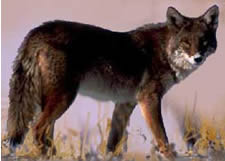
Dimdima
Online Children's Magazine from India

Dimdima
Online Children's Magazine from India

After our exhilarating trip to the Sears tower in Chicago, I’m in the mood to relax in the quiet splendour of my desert environ. As I sit facing the rocky mountains that surround my home, my reverie is broken by a series of high-pitched short yips. It is Bob, my neighbor, practicing his coyote howl in anticipation of an upcoming hunting trip. A seasoned hunter, Bob can imitate a coyote perfectly. Intrigued by his skills and his knowledge about desert wildlife, I decide to walk over to his house in order to learn more about the coyote.
According to Bob, the coyote is a member of the dog family. Zoologists know this animal by the name canis latrans, meaning “barking dog.” A cousin of the gray wolf, it gets its common name from the ancient Aztec word coyotl. The canis latrans is a very adaptable species. Originally these omnivorous creatures were typically found in the low deserts and valleys of the American Southwest. Over the last several years, the growing urban sprawl and the corruption of desert areas by man have forced these animals to migrate to other parts of USA as well. These animals have thus proven that they can change their habits to survive in a wide variety of habitats.
In their natural habitats, the coyote travels alone, in pairs, or in packs. They are very territorial and they mark their boundaries with urine. They are very vocal creatures and use their calls for a variety of purposes. Very often, the still of the desert night is broken by the loud long howls and intermittent short yips of the coyote. Coyotes have a good sense of smell, sight and sound. Coyote dens are usually hidden among rocky crevices. Sometimes, they use holes made by other animals as dens too.
A typical coyote weighs anywhere between 15 to 40 lbs. They are light gray or tan in color. Many coyotes have a black tip on their tails. The tail of the coyote is its distinguishing characteristic. It is rather bushier than that of the average domestic dog. Unlike wolves who hold their tails horizontally, a coyote usually holds its tail straight below the back. In threatening situations, the tail becomes bushier and is held horizontally like that of a wolf. It is capable of running at high speeds of up to 40 mph. Under benign natural conditions, a coyote can survive to be 15 years old.
As the deserts of Arizona and California keep shrinking, reports of coyote aggression are becoming common. These desert predators are soon losing their fear of human beings. Because of their adaptive natures, they have realized that human settlements offer rich food sources. Small pet animals are prime targets for these animals. In recent years, children have also faced some danger from aggressive coyotes hunting for easy prey. As a consequence intensive efforts are being made to hunt down and reduce the coyote population in the United States. Environmentalists are never tired, however, of counseling these hunters about the dangers of unchecked gaming. The coyote is a natural part of the desert, they warn. They play a huge role in maintaining the natural ecosystem of these climes. These conflicting attitudes have been the impetus for many debates in this region. The controversy still rages on.
Dimdima is the Sanskrit word for ‘drumbeat’. In olden days, victory in battle was heralded by the beat of drums or any important news to be conveyed to the people used to be accompanied with drumbeats.
Bharatiya Vidya Bhavan
K. M Munshi Marg,
Chowpatty, Mumbai - 400 007
email : editor@dimdima.com
Bharatiya Vidya Bhavan
505, Sane Guruji Marg,
Tardeo, Mumbai - 400 034
email : promo@dimdima.com
Dimdima.com, the Children's Website of Bharatiya Vidya Bhavan launched in 2000 and came out with a Printed version of Dimdima Magazine in 2004. At present the Printed Version have more than 35,000 subscribers from India and Abroad.